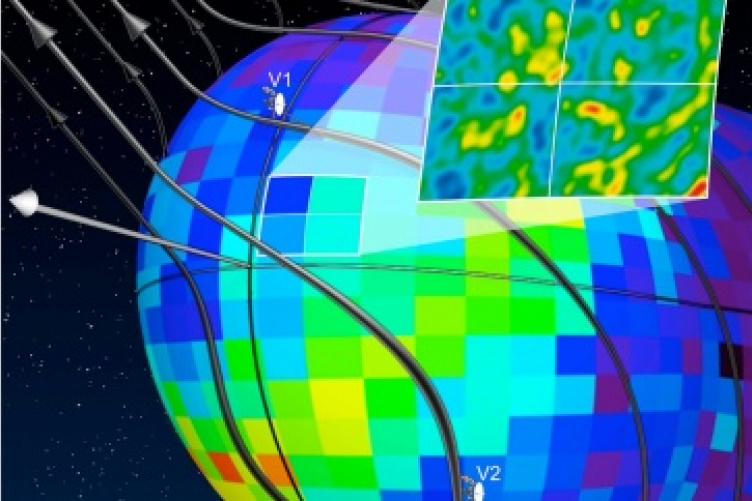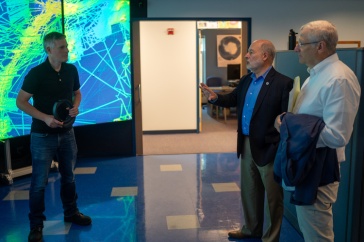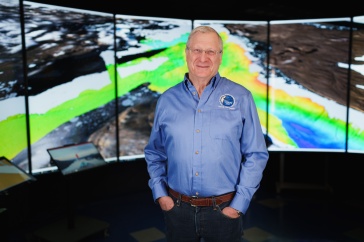
Image of current mapping of heliosphere, done with IBEX, as it looks projected onto the heliopause, one of the boundaries around the solar system. The enlarged box from the map (upper right) shows the more detailed and higher resolution image that will be provided by the new IMAP mission. (Photo: Southwest Research Institute)
“IMAP will make the next generation of measurements to improve our understanding of the global heliosphere, space weather and particle acceleration.”
Researchers and engineers from the University of New Hampshire's Space Science Center (SSC) have been selected to be a part of a science mission by the National Aeronautics and Space Administration (NASA) to sample, analyze, and map particles streaming to Earth from the edges of interstellar space.
“Our journey continues to discover and understand how the sun controls the boundaries of our solar system and how it regulates the space environment where we send astronauts,” says Nathan Schwadron, the Norman S. and Anna Marie Waite Professor of physics and one of the deputy principal investigators overseeing the mission. “We will take the next leap in mapping our global heliosphere, which regulates the entry of galactic cosmic rays into our solar system. These galactic cosmic rays cause radiation exposure that poses risks for humans in space, can damage space instruments, adversely affect our satellites and even influence the Earth’s atmosphere.”
The Interstellar Mapping and Acceleration Probe (IMAP) mission, which is planned to launch in 2024, will help researchers around the world better understand the boundary of the heliosphere, a bubble surrounding and protecting our solar system. The heliosphere’s protection from radiation strongly affects life on Earth. Within the helisophere the constant flow of particles from our Sun, called the solar wind, collides with material from the rest of the galaxy. This collision sets up plasma boundaries in space that limit the amount of harmful cosmic radiation entering the heliosphere. IMAP will collect and analyze particles that are used to map the heliosphere’s boundaries.
“IMAP will make the next generation of measurements to improve our understanding of the global heliosphere, space weather and particle acceleration.” says Schwadron.
The IMAP mission will carry 10 science instruments, including the IMAP-Lo instrument, which is designed and will be built, in part, by a team of engineers and researchers at UNH. The IMAP-Lo instrument will provide imaging of the heliosphere and track the flow of interstellar neutral atoms.
Meet a Researcher
Hear Nathan Schwadron explain his quest to understand how radiation from the sun's solar wind affects us here on Earth.
“This mission continues to shine a light on the strength of UNH’s space program and its scientists, some of the leading researchers in the field,” says Harlan Spence, director of the Institute for the Study of Earth, Oceans, and Space (EOS) and IMAP co-Investigator. “This project comes on the heels of UNH’s successful roles in NASA’s MMS and Van Allen Probes missions and is a great testament to UNH’s expertise. IMAP represents an outstanding opportunity for scientific discovery for UNH researchers and students.”
UNH will also take the lead on the student-based portion of the mission that will give students of diverse backgrounds hands-on experience to design and build a CubeSat, a type of miniaturized satellite for space research, and scientific instruments to study the origin of energy particles in the innermost magnetosphere, a region surrounding the Earth in which charged particles are manipulated or affected by the magnetic field. One of the core objectives of the student project is to target underrepresented populations in STEM, partnering with core institutions like Howard University, Society of Women Engineers, Society of Black Engineers, University of Colorado and Washington, D.C.-area public high schools.
The IMAP mission principal investigator is Prof. David McComas of Princeton University. The Johns Hopkins University Applied Physics Laboratory in Laurel, Maryland, manages IMAP and is designing, building and will operate the spacecraft. The mission is part of the NASA Science Mission Directorate’s Solar Terrestrial Probes Program, managed by Goddard Space Flight Center in Greenbelt, Maryland. For more information, visit IMAP.jhuapl.edu
-
Written By:
Robbin Ray ’82 | UNH Marketing | robbin.ray@unh.edu | 603-862-4864



















































